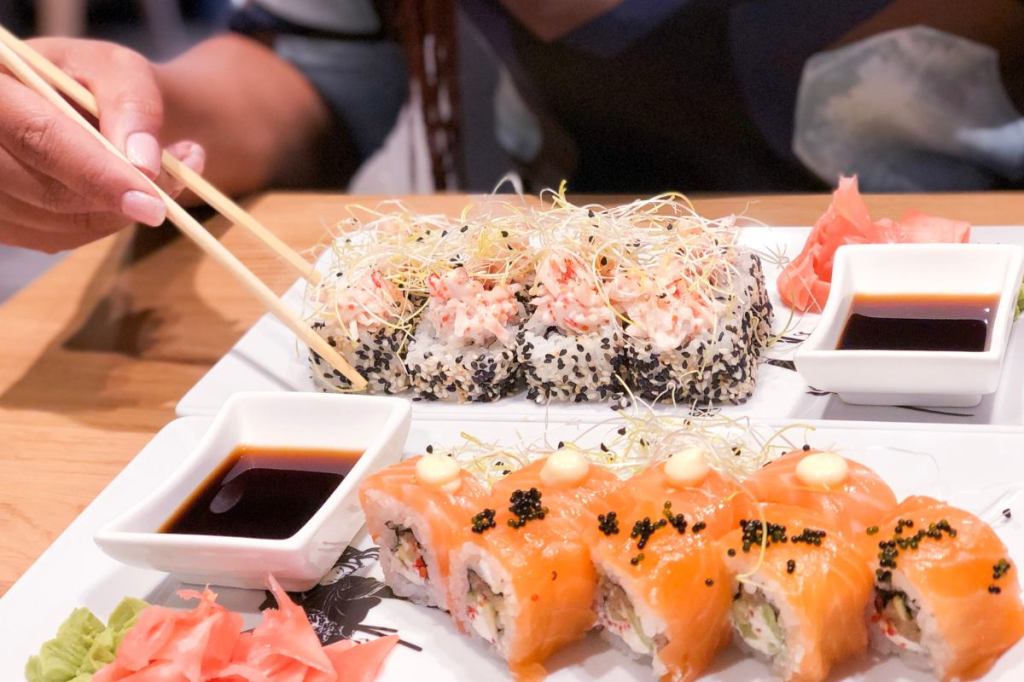Sushi, a culinary delight loved worldwide, comes in various forms, but two distinct types have gained prominence: Conveyor Belt Sushi and Traditional Sushi. In this article, we will delve into the intricacies of each, exploring their unique features, cultural significance, and the preferences of sushi enthusiasts.
I. Introduction
Sushi has transcended its Japanese origins to become a global sensation. With its unique blend of flavors, textures, and artistic presentation, sushi has captured the hearts (and taste buds) of people around the world. In this culinary exploration, we’ll compare two popular sushi styles: Conveyor Belt Sushi and Traditional Sushi.
II. The Concept of Conveyor Belt Sushi

Conveyor Belt Sushi, also known as kaiten-zushi, introduces an innovative dining experience. Imagine a rotating conveyor belt carrying a tempting array of sushi plates directly to your table. This system not only adds an element of fun but also allows diners to conveniently pick and choose their desired dishes.
III. Traditional Sushi: A Culinary Tradition
In contrast, Traditional Sushi embodies centuries-old culinary traditions. Rooted in craftsmanship and precision, traditional sushi is a testament to the art of Japanese culinary expertise. Each piece is carefully crafted by skilled chefs, reflecting a deep respect for the ingredients and the History of Sushi making.

IV. Ingredients and Freshness
The battle of Conveyor Belt Sushi vs. Traditional Sushi extends to the quality of ingredients. While conveyor belt sushi establishments strive to maintain freshness through efficient turnover, traditional sushi relies on the meticulous selection of premium, fresh ingredients, ensuring an unparalleled dining experience.
V. Variety and Customization
The diversity of sushi choices plays a pivotal role in this culinary showdown. Traditional sushi offers a wide range of options, with skilled chefs often accommodating personal preferences. On the other hand, conveyor belt sushi provides a quick and diverse selection, catering to those seeking a variety of flavors without the need for an extensive menu.
VI. Pricing and Accessibility
Price considerations can significantly impact a diner’s choice. Conveyor belt sushi is often perceived as more budget-friendly, appealing to a broader demographic. Traditional sushi, with its emphasis on premium ingredients and craftsmanship, tends to have a higher price point, making it a choice for those seeking a luxurious dining experience.
VII. Dining Experience
The ambiance of the dining experience varies greatly between the two. Conveyor belt sushi restaurants are lively, with the constant movement of plates creating a dynamic atmosphere. Traditional sushi restaurants, however, offer a more intimate setting, allowing patrons to interact with chefs and witness the meticulous preparation of their dishes.
VIII. Health and Nutrition
Nutritional considerations are paramount in today’s health-conscious society. Conveyor belt sushi, with its pre-prepared plates, provides a quick and convenient option. Meanwhile, traditional sushi, with its emphasis on fresh, high-quality ingredients, caters to those looking for a healthier and more wholesome dining experience.
IX. Cultural Influence on Presentation
The cultural influence on presentation distinguishes the aesthetic appeal of each sushi type. Traditional sushi places great importance on presentation, with each piece crafted as a work of art. Conveyor belt sushi, while maintaining a visually appealing presentation, leans towards a more casual and accessible approach.
X. Popularity and Trends
Examining the current popularity trends reveals interesting insights. Conveyor belt sushi has gained traction for its modern and efficient approach, attracting a younger audience. Traditional sushi, however, maintains its timeless appeal, with connoisseurs appreciating the authenticity and craftsmanship.
XI. Customer Preferences
Understanding what drives customer preferences is essential. Some patrons gravitate towards the excitement and variety of conveyor belt sushi, while others seek the tradition and personalization offered by traditional sushi. Factors like speed, ambiance, and individual taste play a crucial role in shaping these preferences.
XII. Challenges Faced by Each Type
No culinary experience is without its challenges. Conveyor belt sushi establishments must contend with the delicate balance of maintaining freshness while minimizing waste. Traditional sushi faces the challenge of adapting to modern lifestyles and preferences without compromising its core values.
XIII. Future of Sushi Dining
Predicting the future of sushi dining involves considering evolving trends and potential innovations. Both conveyor belt and traditional sushi establishments are likely to adapt, incorporating technology and culinary creativity to meet the changing demands of consumers while preserving the essence of sushi culture.
XIV. Conclusion
In the Conveyor Belt Sushi vs. Traditional Sushi debate, the winner is ultimately determined by individual preferences. Whether you seek the dynamic and modern allure of conveyor belt sushi or the timeless traditions of handcrafted, traditional sushi, both offer unique experiences worth exploring. If you’re a sushi enthusiast looking for a delightful dining experience, this sushi bar guide will help you navigate the diverse world of sushi.